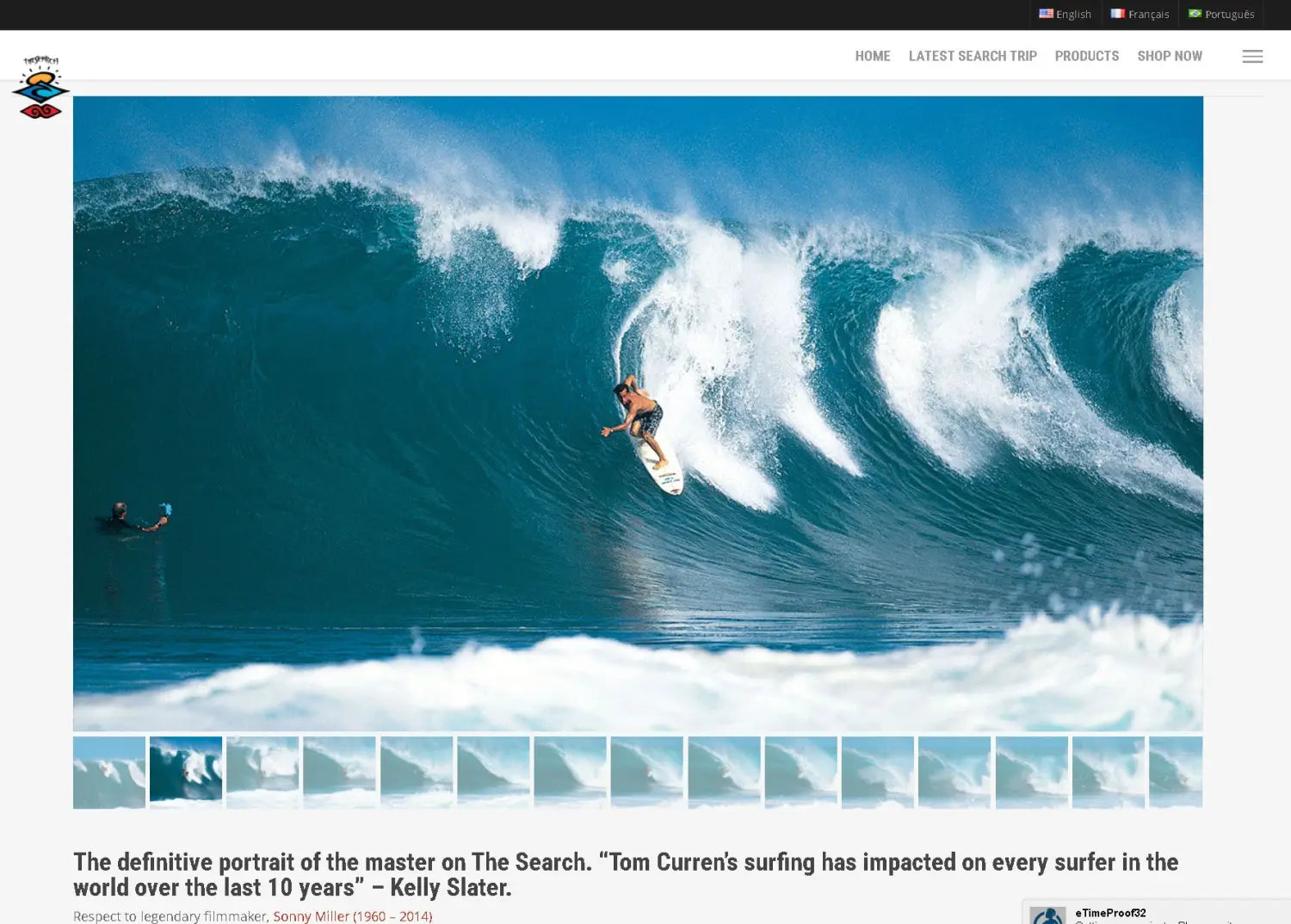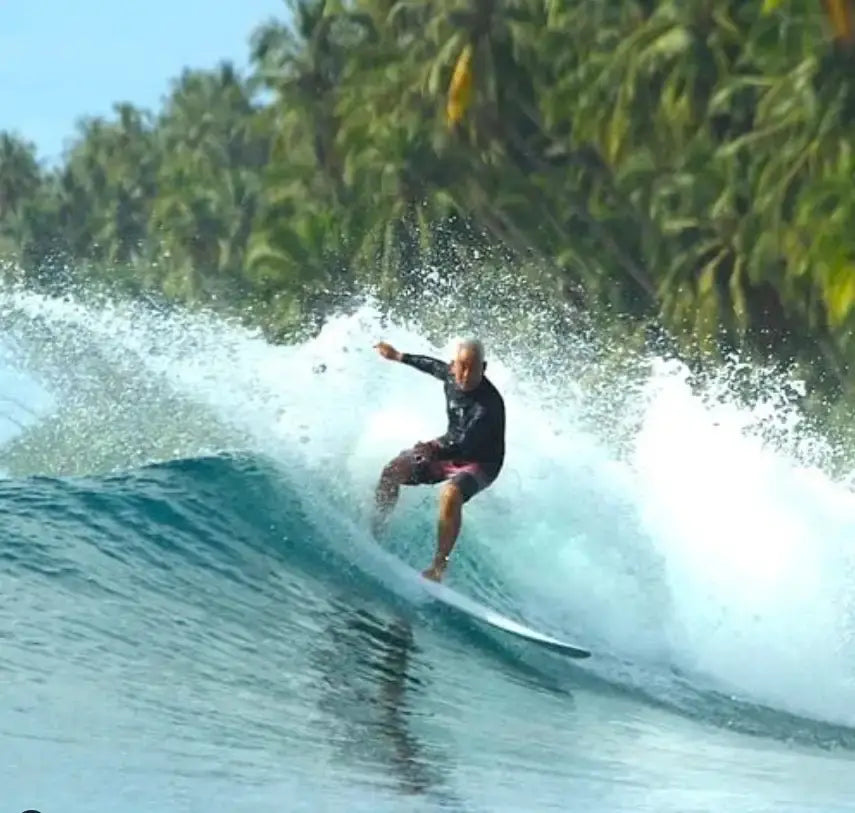Surf Maneuvers Series PART 3: Bottom Turn/Top Turn Combo
Share
Surf Maneuver Tip 3: Bottom Turn/Top Turn Combo
Surf Maneuvers Series by Hawaiian South Shore:
- Surf Maneuvers Series Tip 1: Taking Off on a Shortboard
- Surf Maneuvers Series Tip 2: Pumping Down the Line
- Surf Maneuvers Series Tip 4: Floaters and Foam Climbs
- Surf Maneuvers Series Tip 5: Roundhouse Cutback
- Surf Maneuvers Series Tip 6: The Down Carve
- Surf Maneuvers Series Tip 7: Layback Snap
Once you have mastered pumping down the line and generating your own speed, it’s time to harness that speed into progressive combinations of maneuvers. One of the biggest mistakes that beginner surfers make is to try to force turns—to run before they can walk. They get so fixated on the flashy top turns that they see more adept surfers performing that they miss out on the fact that every good top turn starts with a good bottom turn.
Bottom turns might not be as fancy or celebrated as top turns, but without them, everything else falls apart. If you’ve ever seen someone flying down the line and then abruptly try to force their board into a direction change, you know what I am talking about. Chances are, they ended up on their back, spun out and blown off their board by their own momentum. The reason for this is pretty obvious when you stop and think about it. As we blast down the line, we are carrying a ton of momentum along the critical face of the wave, with our rail engaged and inertia driving us toward the shoulder. If we try to force our boards into a sudden and abrupt change in direction, our rail and fins are going to naturally break free of the face of the wave. Wipeout!
Instead, the key is to focus first on developing a solid bottom turn. As you fly down the line, exit out of a pump at the bottom of the wave and weigh the inside rail, using your speed to carve off the forgiving trough of the wave and carrying your momentum up the face. This is similar to the rock-and-roll carve/pumps that we talked about in tip number two, except that the turn off the bottom is deeper and more committed. It is important to keep your shoulders squared over the stringer and lead with your head. Your arms will naturally follow where your head is going, and your torso, legs, and board will follow your arms. The bottom turn is the fundamental maneuver from which all others result, and the fact that it is often overlooked actually means that you are more likely to learn it properly—as long as you put in the time. No one ever worries about how much spray they are throwing while they bottom turn, which means you are more likely to commit to your rail and flow through the bottom turn, rather than trying to force it. By practicing this maneuver, you are also establishing muscle memory for when you begin to combine the bottom turn with a top turn.

For a textbook example of a proper bottom turn, you can’t beat Tom Curren’s performance at Jeffreys Bay the first time he ever surfed there. This vintage footage from Rip Curl The Search is the stuff of legend and should be part of every surfer’s education. The way Curren commits to his rail through bottom turns indicates that he knows exactly how important this turn is. Rather than treating it like an afterthought or something that has to be endured before he can get to the fun stuff, Curren treats his bottom turn with the respect it deserves—which is exactly why it is so effective in setting him up for his top turn maneuvers.
How deep you draw out your bottom turn will directly affect how vertically you are able to place your top turn without spinning out or breaking your fins loose. A lot of people think that top turns should always be a forced pivot that results in blowing the tail out because that’s what they see the pros doing. What they don’t realize is that the radical, aggressive blowtails that pros are doing are actually drawn-out rail turns taken to their extreme and performed so quickly and in such a tight arc that they ultimately result in the fins breaking loose—but in a controlled manner. The key to this is to prepare for the top turn with the appropriate rail turn off the bottom—and then to replicate that same rail turn, but using the opposite rail as you carve back down the face.

Rather than trying to smash the lip your first go, start by extending your pump rock-and-roll maneuver so that it goes a little bit farther off the bottom and a little bit farther up the face each time. Eventually, you will start to develop a feel for what sort of turns can fit in different sections of the pocket, depending on how deep you are and how hollow the wave is. Remember that the goal is to always be true to your inside rail during your bottom turn and your outside rail during the redirection of your top turn—leading with your head, then following with your arms, torso, legs, and eventually board.
Once you have begun to master this combination of bottom and top turn, start experimenting with deeper bottom turns to set up more vertical top turns—but only when the section calls for it. If you come hard off the bottom and try to go straight up into a soft section that doesn’t have a lip, you will inevitably bog because there’s nothing for you to push against. On the other end of the spectrum, if you want to do a turn in a hollow section, you need to come hard off the bottom so that your board can track straight up into the lip without spinning out. Finding this balance and learning to read the wave as it breaks in front of you is the key to a good bottom turn/top turn combo.
Eventually, you will find that you are able to carry enough speed through your bottom turn and up into critical sections that your top turns start to feel less like carves and more like snaps. But it is important to remember that a good snap is still just an extension of a carve—it’s a carve that is so fast, so aggressive, and in such a critical section of the wave that its turning radius becomes virtually indistinguishable, causing it to appear as an instantaneous change in direction.
Frontside bottom turns and top turns are easier to visualize in your mind, as you are facing the wave and attacking it on your toe-side rail as you come off the bottom. The upper body naturally wants to follow through as you enter your frontside top turn, and the biggest challenge is knowing how hard to push and remembering to commit to your rail carve. Backside bottom turn/top turn combos are much more difficult to perfect, although guys like Mark Occhilupo are a great example of people who have mastered the art.
Find footage of Occy at J-Bay or Bells Beach and watch how he fully commits to his backside bottom turn, projecting all the way into the flats and then up into the face, virtually dragging his butt on the water as he uses his hips to drive the board through the turn. This setup off the bottom allows him to approach the face or the lip (depending on the section) with so much speed and rail projection that his top turns appear almost effortless. The reality, however, is that he is fully committed to his rail as he transitions into his top turn, carving the board through the top third of the wave and pushing hard as he follows through. Once again, the modern backside.
